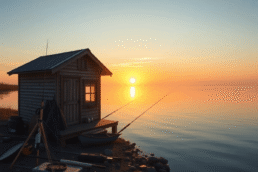Introduction
Choosing the right bait color can significantly impact your fishing success. It’s not just about tossing any lure into the water; it’s about understanding how different hues interact with various fishing conditions. The color of your bait can influence how visible and attractive it is to fish, which directly affects your catch rate.
This article serves as a comprehensive guide to help you navigate the nuances of bait color selection. By considering specific fishing conditions and adapting your strategy accordingly, you’ll enhance your chances of success on the water. Whether you’re dealing with clear waters or stained environments, mastering bait color choice is key to reeling in more fish.
Understanding Water Clarity and Its Impact on Bait Color Choice
1. Murky Water Conditions: Dark Colors for Maximum Visibility
Water clarity is a crucial factor in bait color selection, influencing how fish perceive and react to your bait. In murky water conditions, visibility can be severely restricted, often limited to just one or two feet. This poses a challenge for anglers, as fish may struggle to detect baits unless they stand out against the murky backdrop.
Characteristics of Murky Waters:
- Limited Visibility: Particles suspended in the water reduce clarity.
- Dark Background: The water’s cloudiness creates a darker environment beneath the surface.
In these conditions, fish rely heavily on silhouettes rather than color detail to locate prey. It’s essential to choose bait colors that maximize visibility by creating a strong contrast against the murky water. Dark colors excel in this regard.
Recommended Dark-Colored Baits:
- Dark Purple
- Black
These colors are particularly effective because they provide a pronounced silhouette that can catch the attention of fish from a distance. By opting for dark-colored baits, you’re enhancing the likelihood of attracting fish in conditions where visibility is otherwise compromised.
Consider using baits with significant movement or vibration features alongside their dark hues. This combination not only improves visibility but also appeals to other senses fish use when hunting in low-visibility environments.
When selecting a bait for murky waters, remember that it’s not just about the color. Factors such as size, shape, and movement can also play critical roles in drawing fish towards your lure.
By understanding the characteristics of murky waters and choosing appropriate dark-colored baits, you enhance your chances of success significantly. This approach ensures your offerings stand out dramatically against the dim background typical of such environments, making them more enticing and noticeable to potential catches.
However, it’s worth noting that branding plays an important role in marketing fishing lures as well. Just like in other industries, branding can significantly influence consumer perception and product desirability in the fishing tackle market.
2. Stained Water Conditions: Natural Hues That Fool Fish
Understanding water clarity is crucial in bait color selection, particularly when dealing with stained water conditions. Stained water often exhibits a tea-colored tint, typically resulting from organic materials like decaying vegetation or tannins in the water. This type of water clarity falls between murky and clear, offering its own unique challenges and opportunities.
In these environments, fish rely heavily on visual cues that closely resemble their natural prey. Natural hues such as green pumpkin or brown are ideal choices. These colors mimic the natural tones of the environment and the appearance of prey species common in these waters, making them less conspicuous to fish but still effective at attracting bites.
Green pumpkin mimics the earthy tones found in many aquatic settings, while brown reflects the subtle natural shades that blend seamlessly with stained water surroundings. By understanding how stained water affects visibility and fish behavior, anglers can make informed decisions about bait color selection to increase their chances of success.
3. Clear Water Conditions: Lighter Colors for Subtle Mimicry
In fishing, water clarity plays a crucial role in deciding which bait color to use. When you’re in clear water conditions, where you can see more than ten feet underwater, picking the right bait color becomes really important. Fish in clear water are used to getting a good look at their prey, so they’re more picky and careful about biting.
Clear waters let fish spot bait from far away, which affects how they behave and makes subtle, lifelike presentations work better. In these situations, go for lighter colors like white or light gray. These hues are great at imitating the natural look of baitfish bellies, creating a realistic and unobtrusive shape that fish find hard to resist. The subtle mimicry of lighter-colored baits can effectively entice even the most selective fish.
Here are some specific colors to consider:
- White: Known for its versatility in clear water, it replicates the reflective nature of real baitfish.
- Light Gray: Offers a subdued contrast against the bright environment, enhancing its realism.
By understanding how water clarity affects fish behavior and visibility, you can adjust your bait color choice accordingly to increase your chances of catching fish in clear water conditions.
Exploring Color Tones in Bait Selection for Different Fishing Strategies
1. Soft Pinks and Pale Yellows: The Subtle Power of Light Colors
Choosing the right bait color can significantly influence your fishing success. When it comes to soft pinks and pale yellows, these light colors hold a unique power in specific water conditions. Their subtlety makes them particularly effective when targeting fish in clear or lightly stained waters, where visibility is higher, and fish behavior becomes more cautious.
1.1 Mimicking Natural Prey
Soft pinks and pale yellows resemble the natural hues found in many small baitfish and aquatic insects. This mimicry becomes crucial in clear water, where fish can scrutinize their prey more closely. A pale yellow bait gliding through the water can replicate the appearance of a sunlit minnow, while a soft pink might imitate the underbelly of a small shrimp or worm.
1.2 Avoiding Overstimulation
In environments where water clarity is high, using excessively bright or dark tones can startle fish rather than attract them. Light-colored baits blend seamlessly into the surroundings, providing just enough contrast to catch a fish’s attention without being overly intrusive.
1.3 Complementing Fishing Strategy
Incorporating soft pinks and pale yellows into your fishing strategy involves understanding the behavior patterns of your target species. For example, during early mornings or late afternoons when light levels are softer, these colors maintain their effectiveness by reflecting ambient light subtly.
1.4 Versatility Across Species
Whether you’re angling for bass, trout, or panfish, light-colored baits such as soft pink worms or pale yellow jigs offer versatility across species. This adaptability allows you to switch targets easily without constantly changing your tackle.
Incorporating these colors into your fishing arsenal can be a game-changer when conditions align perfectly with their use. By adopting a strategic approach to bait color selection tailored to specific environmental factors, anglers enhance their chances of enticing even the most wary fish. Soft pinks and pale yellows are not just alternate options; they represent strategic choices grounded in an understanding of aquatic ecosystems and fish behavior dynamics.
2. Chartreuse Madness: Bright Colors That Demand Attention from Fish
In the world of fishing, bright colors like chartreuse are incredibly important when it comes to choosing the right bait. These colors have a unique ability to stand out even in difficult conditions, making them a top choice for anglers.
Understanding Color Tones in Bait Selection
To develop an effective fishing strategy, it’s essential to understand the three main color tones used in bait selection:
- Lights: Soft pinks and pale yellows fall into this category. They are subtle yet effective in clear or lightly stained waters.
- Brights: These are bold and vibrant colors like chartreuse that demand attention. They are specifically designed to attract fish.
- Darks: Darker shades can be effective in certain situations but may not have the same impact as bright colors.
The Role of Chartreuse in Murky Environments
When fishing in murky waters where visibility is poor, fish rely more on movement and contrast rather than color details. This is where chartreuse baits come into play. Their brightness cuts through the muddiness, making them highly visible to fish and alerting them to potential prey.
Practical Application of Chartreuse in Fishing
Anglers often use chartreuse in various types of bait such as spinnerbaits or crankbaits to take advantage of its visibility advantage. By incorporating this bright color into your tackle box, you increase your chances of success in stained waters where other colors may not be as effective.
Remember, when fishing in challenging conditions, don’t underestimate the power of bright colors like chartreuse!
3. Black Baits Reigning Supreme: Harnessing Low Light Conditions with Dark Colors
Black baits are a powerhouse in low light conditions, where their effectiveness is rooted in their ability to create a distinct silhouette. Fish often depend more on movement and shape than color contrast when visibility is limited, making black baits the perfect choice under these circumstances.
Why Black Baits Excel:
- Silhouette Effect: In dim lighting, black or dark-colored baits cast a strong outline against any background. This silhouette effect becomes a critical factor in drawing attention from fish as it mimics the shadowy form of prey.
- Versatility Across Water Types: Whether it’s dawn, dusk, or overcast days, the adaptability of black baits shines through. The dark tones maintain their visibility across varying water clarities, unlike brighter colors that may become too glaring or washed out.
- Natural Mimicry: Many bait types such as soft plastics and jigs frequently come in black hues due to their success in mirroring natural prey like leeches or darker minnows.
When crafting your fishing strategy, consider incorporating black baits to leverage these advantages. Understanding the role of color tones—lights for clear waters, brights for stained environments, and darks for low light—can significantly enhance your fishing success.
Adapting Bait Colors to Specific Situations for Enhanced Success Rates
Certain fishing scenarios require careful consideration of bait color selection, which can greatly affect success rates. Here’s how you can adapt your bait colors based on specific situations:
Spawning Season
During the spawning season, fish become more aggressive as they protect their nests from intruders. You can take advantage of this behavior by using brighter colors, such as fluorescent orange or red. These attention-grabbing hues provoke defensive responses, causing fish to strike more forcefully.
Fall Fishing Tactics
Fall fishing tactics often involve adjusting to the changing behavior of fish as they prepare for winter. During this time, fish actively feed to build up energy reserves. Using bright crankbaits, like chartreuse or vibrant shad patterns, can imitate the abundant baitfish that fish seek during these months. These colors stand out in the cooler, often murky fall waters and attract attention with their visibility.
Seasonal Changes
Understanding the environmental conditions and tailoring your bait choices accordingly is crucial when adapting to seasonal changes:
- Spring: Opt for bright and flashy colors that stimulate reaction bites.
- Summer: Consider using natural hues like watermelon or green pumpkin that match abundant summer prey.
- Fall: Bright colors such as chartreuse are ideal for active feeders.
- Winter: Darker tones like black or deep blue can be effective in low-light conditions.
The key is to observe the specific situation and apply these insights into selecting the right bait color for any fishing condition. By aligning your strategy with the seasonal behaviors of fish, you increase your chances of a successful catch.
Just as in fishing where adapting strategies according to specific situations can lead to a successful catch, a similar approach can be applied in other areas such as home improvement. For instance, if you’re considering a kitchen remodel on a budget, understanding your specific needs and tailoring your choices accordingly can yield impressive results without breaking the bank.
The Role of Personal Confidence in Successful Bait Color Selection
Choosing the right bait color isn’t just about analyzing water conditions or fish behavior; it’s also about personal confidence. Confidence can significantly impact your fishing success, as it influences how effectively you use your chosen bait.
Factors Influencing Bait Color Selection
Several factors come into play when determining which bait color to use:
- Personal Preference: Every angler develops a preference for certain bait colors based on past experiences. These preferred shades often become go-to choices because they have yielded favorable results before. Whether it’s the soft pinks that consistently attract bass in spring or the bright chartreuse that draws attention during murky conditions, personal experience plays a crucial role.
- Angler Experience: Over time, you gather insights from various fishing trips that shape your color choices. These experiences build a strong foundation of knowledge and help you make informed decisions. For example, if you’ve noticed chartreuse performing well during overcast days, you’re likely to reach for it when similar weather patterns arise.
- Open-Mindedness: While personal preference is important, staying open to new options is equally vital. Fishing conditions are dynamic, and what worked yesterday might not work today. Experimenting with different colors can lead to unexpected successes and expand your repertoire of effective baits.
In essence, how I choose the right bait color for any fishing condition often boils down to a blend of personal confidence and adaptability. Trust in your past experiences, but remain willing to explore new possibilities. This balance ensures you’re always prepared to tackle whatever challenges the waters present.
Related Posts
May 19, 2025
How to Keep Fishing Fun When It Becomes a Business
Learn how to keep fishing fun and fulfilling while balancing passion, business…
May 18, 2025
DIY or Hire a Pro? When to Call a Handyman in Lake County
Discover when to DIY or hire a handyman in Lake County for home repairs,…
May 17, 2025
The Challenges of Growing a Business During Inflation—and How We’re Tackling It
Learn practical strategies to manage costs, cash flow, and pricing for…



